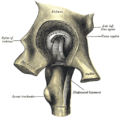Ischium: Difference between revisions
CSV import Tag: Manual revert |
CSV import Tags: mobile edit mobile web edit |
||
| Line 29: | Line 29: | ||
{{stub}} | {{stub}} | ||
== Ischium == | |||
<gallery> | |||
File:Pelvic_girdle_illustration.svg|Illustration of the pelvic girdle | |||
File:Gray341.png|Gray's Anatomy illustration of the ischium | |||
</gallery> | |||
Latest revision as of 02:10, 17 February 2025
Ischium
The Ischium is one of the three parts of the hip bone, or os coxae, the other two being the ilium and the pubis. The ischium forms the lower and back part of the hip bone and is located below the ilium and behind the pubis.
Structure[edit]
The ischium is divided into three main parts: the body, the superior ramus, and the inferior ramus. The body forms approximately one-third of the acetabulum, which is the socket that accommodates the head of the femur (thigh bone). The superior ramus projects upward from the body, contributing to the acetabulum and connecting with the ilium. The inferior ramus extends downward from the body, connecting with the ramus of the pubis.
Function[edit]
The ischium provides support in the sitting position. The ischial tuberosity, a roughened area on the lower part of the ischium, bears the weight of the body when sitting. The ischium also provides attachment for various muscles, including the adductor muscles of the hip and the hamstrings.
Clinical significance[edit]
Injuries to the ischium can occur as a result of trauma, such as a fall, or from overuse in activities that involve a lot of sitting or bending at the hip. Fractures of the ischium are relatively rare but can be associated with significant morbidity. Treatment typically involves rest, pain management, and physical therapy. In some cases, surgical intervention may be necessary.




